By Meg Albers

Kites Go To School
By Meg Albers

Kites have been around for a long time. They have been used as an educational tool from the beginning. Teleport yourself to virtually any period in kite history and you will see kites being used to gather information, or to dispense it. Kites inherently educate. The basic ability to fly a kite teaches lessons of aerodynamics and physics, often without the flyer being openly aware of the lessons they are absorbing.
Anyway you look at it, whether you are making, designing or building a kite, kites can enhance the learning process. Alexander Wilson used a train of kites in 1749 to learn about the atmosphere. The teacher, George Pocock, used kites in 1827 to pull a horseless carriage through the English countryside. He taught his students that there is always more then one way to do something. In 1943, Dr. Paul Garber designing a kite for target practice so sailors could learn to be a better shot with their big guns. In April 2002, National Geographic Magazine reported that scientists from Mexico and the US used kites to monitor atmospheric pollutants at 4000 feet.
The same can be said of kite clubs all over the world. They have been around for a long time, and their members have been using kites to educate almost as long. The word educate is in every mission statement I have ever read. I find this to be one of the most honorable attributes of people in the kite world. Most kite flyers seem to have two common denominators in their characters; their love of travel, and their intrinsic nature to share their knowledge and skill with others, especially children.
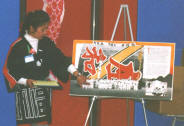 When
I started doing educational workshops and presentations with kites in the late
eighties, I relied on the help of previous great kite educators. They had taken
the time to generously put their information and materials into books for me to
buy and use. Margaret Gregor’s Kites for Everyone book series and
Wayne Hosking’s Flights of Imagination, published by the
National Science Teachers Association, were like bibles to me.
When
I started doing educational workshops and presentations with kites in the late
eighties, I relied on the help of previous great kite educators. They had taken
the time to generously put their information and materials into books for me to
buy and use. Margaret Gregor’s Kites for Everyone book series and
Wayne Hosking’s Flights of Imagination, published by the
National Science Teachers Association, were like bibles to me.
I also came upon Beth Matthews’ terrific little book called Kite Folds, published in Australia in 1987. It wasn’t the content of the book that cranked my tractor, although that was very good content, but it was the very last page in the book. There was an addendum for teachers on the last page of the book titled: The Kite as an Educational Tool. Beth Mathews used kites to make curriculum correlations with a variety of subjects for various grade levels. I could not have been more thrilled. It really made me look at the multitude of ways and range of opportunities there are to teach with kites. Not only were kites an artistic medium and sport, but also the ultimate in educational venues. (Kite-Folds can be found in the Australian section of www.kitelife.com bookstore.)
Fortunately, it was about this time that teachers, school districts, and boards of education had come to realize that students learn much more efficiently if they are engaged. Interested students taught by enthusiastic teachers about exciting subject matter is key to learning. Geometry is much more palatable when it is taught by making Alexander Graham Bell’s tetrahedron kites. Learning about the explorer Marco Polo, is more fun when the students learn that he wrote in his travel journal about seeing man-lifting kites in China.
Kites can be added to any teachers’ lesson plans and still remain consistent with their state’s Educational Learning Standards. Kites can be geared to any age and grade level, from pre-K to University. For years now, Richard Dutton has had Lam Hoac perform indoor flying demonstrations for the incoming freshmen engineering students at the University of Buffalo.
I continue to search out additional educational materials that help to combine kites and education. The following two books were a great find:
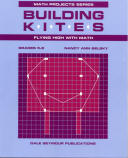 Nancy
Ann Belskys book BUILDING KITES ~Flying High With Math ~Grades
5-8 was published by Dale Seymour Publications in 1995 and is available at
www.KiteLife.com bookstore. This has been an
exceptional resource that includes
lesson plans, student objectives, and kite plans for three detailed projects.
This is perfect for combining middle school, geometry, and Bell’s
tetrahedron
kites.
Nancy
Ann Belskys book BUILDING KITES ~Flying High With Math ~Grades
5-8 was published by Dale Seymour Publications in 1995 and is available at
www.KiteLife.com bookstore. This has been an
exceptional resource that includes
lesson plans, student objectives, and kite plans for three detailed projects.
This is perfect for combining middle school, geometry, and Bell’s
tetrahedron
kites.
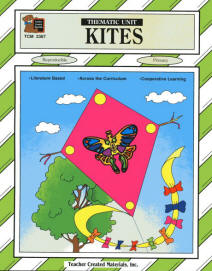
KITES Thematic Unit for Primary Grades (1-3) written by Carole Davis, Andrea Dick, and Brenda Sampson, M.A. was published in 2000 by Teacher Created Material and is available at www.teachercreated.com (TCM 2367). This book is a true treasure-trove. It contains a wealth of information and material that you will find very valuable and return to again and again.
Opportunities to present the fascinating implications of kiting come in many forms. I am most anxious to report about an organization called Young Audiences (www.youngaudiences.org), a forty-two year old national organization, with thirty-two individual chapters. It is the Western New York chapter (www.yawny.org) that I am most familiar with. Their Mission is “…to make the arts a part of young people’s education in order to enhance their development as creative and productive human beings.”
Young Audiences primary purpose is to bring the arts and children together. They provide arts services in urban, suburban, and rural schools. Often with funding generated by Young Audiences. They also participate in many community events and festivals, as well as providing after school and summer residencies in clubs and community centers.
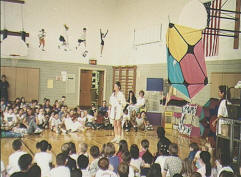 Young
Audiences integrates the arts into the education curriculum for grades pre-K to
12th. They began as a music-based organization but now include all
the arts. Long term residencies and individual workshops are offered to have the
arts genuinely become a part of the children’s education. They also offer
developmental opportunities for teachers and teaching artists. The inclusion of
art education in schools has changed drastically over the years and one school
district to another has radically different provisions available. Through the
years and the changes Young Audience has found a way to evolve and grow.
Young
Audiences integrates the arts into the education curriculum for grades pre-K to
12th. They began as a music-based organization but now include all
the arts. Long term residencies and individual workshops are offered to have the
arts genuinely become a part of the children’s education. They also offer
developmental opportunities for teachers and teaching artists. The inclusion of
art education in schools has changed drastically over the years and one school
district to another has radically different provisions available. Through the
years and the changes Young Audience has found a way to evolve and grow.
When my neighbor found out I was combining kites and education in my own quiet way…ok maybe not so quietly…she told me I had to call Young Audiences. From the first conversation I had with them I knew I wanted to be involved with this organization.
Young Audience was interested in learning about how I incorporated the kites and education. They are smart talented people who saw the vast educational potential of kites.
At the initial interview in their office, I brought some of the materials that I used and explained what my various programs contained. I stated my mantra, “kites can be used in any lesson plan for any grade in any subject”. After they had a chance to observe the next school program I had scheduled, I was invited to be in their program catalog.
After I got the panic attack under control, I sat down and wrote thirty curriculum correlations in three days. The first one was the hardest. When it was finished I was pleased to finally have it all documented.
The catalog will be distributed widely in Western New York and Young Audience will act as my agent. The kite workshops will basically be the same as they were before, it’s just now I will be consistently paid. Young Audiences is much better at looking out for my best interest then I am, as well as seeing the value of kite education and my programs.
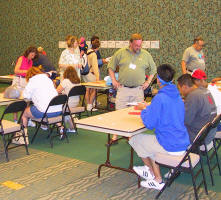 Young
Audiences funding comes from a variety of sources, everything from the
National Endowment for the Arts through to local city, county and state
grants. A multitude of private foundations, organizations and corporate America
also contribute.
Young
Audiences funding comes from a variety of sources, everything from the
National Endowment for the Arts through to local city, county and state
grants. A multitude of private foundations, organizations and corporate America
also contribute.
There are many AKA members that have been doing school workshops that could be huge assets to their local Young Audience chapters. It would be a mutually beneficial partnership for all involved with the students really gaining the most. It is an opportunity to incorporate kites into mainstream education, while introducing a new generation to the endless possibilities of the kite.
References
Books:
Kites – The Science and the Wonder, by Dr. Toshio Ito & Hirotsugu Komura
Flights of Imagination: An Introduction to Aerodynamics, by Wayne Hosking
Kites For Everyone, by Margaret Gregor
More Kites For Everyone, by Margaret Gregor
Kite-Folds – Aerodynamic Paper Inventions, by Beth Matthews
Building Kites – Flying High With Math, by Nancy Ann Belsky
Kites Thematic Unit, by Carole Davis, Andrea Davis & Brenda Sampson, M.A.
Magazines:
National Geographic, April 2002, Pg. 122, Bat Patrol by Gary F. McCracken & John Westbrook
Colors Of The Wind – A Guide To Modern Kiting, 1997, by Cory Jensen
Catalogs:
Young Audiences of Western New York, Inc., 2001 – 2002 Program Catalog
Internet:
© M. Albers, 2002